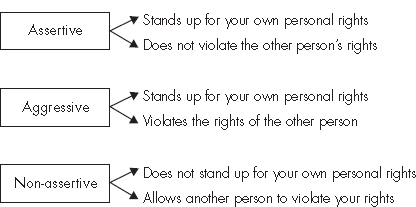
For someone with AN, the rationale behind learning to be more assertive is that it may provide you with a tool other than food avoidance to get what you want. Learning to be assertive requires practice, and it is not easy to teach by way of a self-help manual. However, the information presented here can be used as a set of guidelines with which you can experiment, to give you a starting point on which you can build as you gain in confidence.
What does ‘being assertive’ mean? To start with, it may be useful to review a ‘Bill of Assertiveness Rights’, taken from Manuel J. Smith’s book When I Say No, I Feel Guilty:
1 You have the right to judge your own behavior, thoughts and emotions and to take the responsibility for their initiation and consequences upon yourself.
2 You have the right to offer no reasons or excuses for justifying your behavior.
3 You have the right to judge if you are responsible for finding solutions to other people’s problems.
4 You have the right to change your mind.
5 You have the right to make mistakes – and be responsible for them.
6 You have the right to say, ‘I don’t know.’
7 You have the right to be independent of the goodwill of others before coping with them.
8 You have right to be ‘illogical’ in making decisions.
9 You have the right to say, ‘I don’t understand’.
10 You have the right to say, ‘I don’t care.’
In any form of communication, be it verbal or non-verbal, there are three different ways to act:
So what differentiates these three different types of behavior?
As you can see from Figure S7.1, assertive behavior involves standing up for your own rights – expressing your thoughts, feelings and beliefs in a way which
It involves respect, not submission. You are respecting your own needs and rights as well as accepting that the other person also has needs and rights.
Figure S7.1 Assertive, aggressive and non-assertive behavior

This involves standing up for personal rights and expressing your own thoughts, feelings and beliefs in a way which
The usual goal of aggression is domination and winning, forcing the other person to lose. Winning is ensured by humiliating or overpowering other people so that they become weaker and less able to express and defend their needs and rights. The message is:
This involves not standing up for your own rights by
The message communicated is:
So, it means you are not respecting your own rights and needs. The goal of non-assertion is to appease others and avoid conflict at any cost.
Figure S7.2 shows three different possible responses to a single scenario: one aggressive, one assertive, one non-assertive. The following exercise will help to clarify what we mean by the words ‘assertive’, ‘non-assertive’ and ‘aggressive’, consolidate the different types of responses available to you and help you to see which type you routinely use.
Figure S7.2 Assertive, aggressive and non-assertive responses
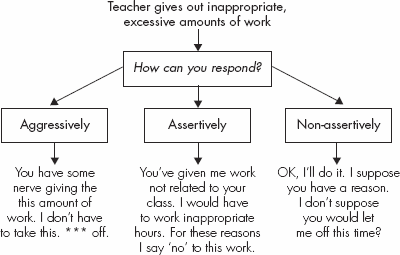
For each situation below, make suggestions for what you think the three types of responses might be: i.e. not how you would behave under the circumstances, but how you think an aggressive, non-assertive or assertive person might respond.
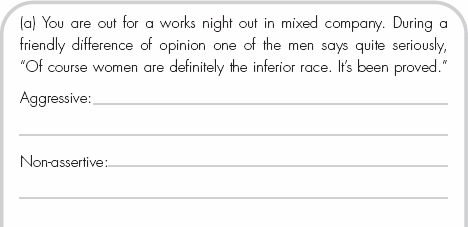
Now look back over your answers and note, for each case,
Assertive behavior increases your own self-respect, leading to greater self-confidence and thus reducing the need for others’ approval. Usually, people respect and admire those who are responsibly assertive, showing respect for self and others. Assertion results in individuals having their needs satisfied and preferences respected.
Now that we can differentiate assertive behavior from aggressive and non-assertive, we need to look to different types of assertion and when to use them.
Figure S7.3 shows five different types of assertion, each of which suits a different situation. We will now look at each one in greater depth and give examples to show the type of situation in which it is used most appropriately.
Figure S7.3 The five types of assertion
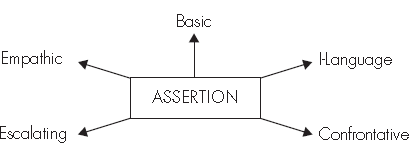
This is expressing basic personal rights, beliefs or feelings, e.g.
This is expressing your needs/feelings, but also showing sensitivity to the other person, e.g.
This starts with a minimal assertive response, usually achieving the goal with minimum of effort. When the other person fails to respond and continues to violate your rights, you gradually increase the assertion and become increasingly firm without becoming aggressive. For example, say you are in a bar with a friend and a man repeatedly offers to buy you drinks.
The final, blunt refusal was appropriate because the earlier assertions were ignored.
This is used when the other person’s words contradict what he/she does. This type of assertion involves describing what the other person said would be done, what they actually did, and what you want done, e.g.
This is assertively expressing difficult negative feelings. e.g.
If behaving assertively is new to you, you might find it helpful to use Figure S7.4 to formulate a basic plan of how you are going to approach each new situation.
If, to begin with, you don’t feel confident enough to behave assertively with everyone, then try doing some role-playing with a close friend at home before launching the new, assertive you on the rest of the world.
Figure S7.4 An approach to behaving assertively
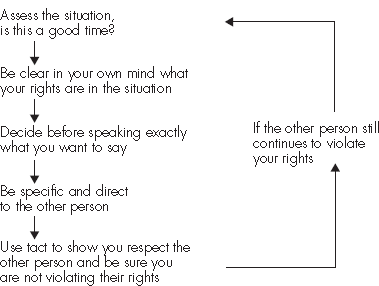
Beccie, a 27-year-old office worker, had suffered from AN for five years. She had low self-esteem and was very miserable both at home and at work. After a hard day at work she came home to start the cooking, cleaning and ironing, running after the children and her husband. The list of tasks was endless. She was unable to see any way out, feeling that it was her duty to do all this work and feeling guilty for moaning about it. Occasionally she felt like screaming at her husband for help but was scared of what he might do in response.
A friend suggested that Beccie join an assertiveness class with her. She decided to go along although she was doubtful that it would help. She was taught about ‘The Bill of Assertiveness Rights’ and how to act assertively, practising in class by role-playing. Soon she began to realize that looking after the home was not her sole responsibility and that it was acceptable to ask her family for help. Her family put up some resistance initially as they did not like having to do ‘Extra’ work, but she prodded them along, using her new-found assertive techniques. Soon Beccie found that life was somewhat easier and more enjoyable.
Like Beccie in the case history described above, you may have more than one reason why you don’t act assertively. In her case it was a combination of failure to accept that she had personal rights, and anxiety about the negative consequences. Once she became convinced that she did have rights and feelings, that she was entitled to just as much consideration as any other human being, she was able to act more assertively, at which point she found that the negative consequences were not as bad as she had feared.
Other reasons for acting non-assertively are:
If you are frequently non-assertive, you will feel a growing loss of self-esteem, and an increasing sense of hurt and anger. Internal tension may result (as with Beccie). Close relationships can be difficult without honest expression of thoughts and feelings. Other people may feel irritation about the non-assertive person, leading to a lack of respect.
If you are frequently aggressive, you might lose or fail to establish close relationships and feel that you have to be constantly on the watch for counter-attacks. You might lose your job, miss out on promotion, develop high blood pressure, and feel misunderstood and unloved; and you may feel guilt, shame or embarrassment after your aggression.